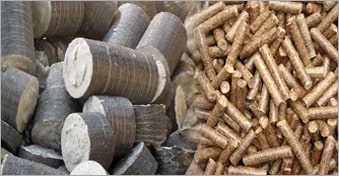It is the only thing that ever has.

APPLICATIONS PRODUCT

- Spinning Mill
- Pharmaceuticals
- Food processing Industries
- Lamination Industries
- Textile Unit, dyeing plants
- Ceramic and refectory Industries
- Leather industries
- Brick making units
- Cement
- Oil Industry
- Milk plant
- Tyre Industries
- Bottling Plants
When the going gets
tough ,the tough go
green!
HISTORY
With the growth in biomass briquetting industry these pollution and energy losses are now under great control. This also adds value to the agro-waste generated; resulting in an increase in the farmers’ net income.
COMPARISION WITH COAL
- Raw materials can be produced domestically in India, creating a fuel source that is free from foreign dependence and less polluting than raw fossil fuel incineration.
- Combustion is more uniform as compared to coal. Due to high quality of volatile matter, boiler response to volatile matter is faster.
- Environmentally, the use of biomass briquettes produces much fewer greenhouse gases, specifically,13.8% to 41.7% CO2 and NOX.
AN OVERVIEW
India currently generates about 960 million tonnes of solid waste annually as a by-product of industrial, mining, municipal, agricultural and other processes. Of these 350 million tonnes are organic wastes from agricultural sources; 290 million tonnes are inorganic waste of industrial and mining sectors and 4.5 million tonnes are hazardous in nature.
Industrialization, urbanization, population growth, economic growth, improvement in per capita consumption of electricity, depletion of coal reserves, increasing import of coal, crude oil and other energy sources and the rising concern over climate change have put India in a critical position. It has to take a tough stance to balance between economic development and environmental sustainability.
As per the study conducted by the UN, Indian CO2 emission has increased by a whopping 7.7%, With those from coal growing by 10.2% as compared to last year. To safeguard the environment, efforts are being made to RECYCLE different waste and utilise them in VALUE ADDED APPLICATIONS.
planet is the belief that
someone else will save it!
EYE OPENERS
India has been able to achieve only 19 % of its renewable energy potential till 2019. The untapped market potential for overall renewable energy in India is 21692 MW, which shows a huge growth potential for renewable energy.
Having an estimated potential of 30000 MW of power from biomass, out of which only 3000MW has been exploited, over 90% of the potential capacity lies untapped.
The physio-chemical properties of waste depend on the properties of raw material, mineralogical origin, operating process, and their efficiency.
A major quantity of waste generated from agricultural sources are sugarcane bagasse, paddy and wheat straw and husk, vegetables, food products, tea, oil production, jute fibre, groundnut shell, wooden mill waste, coconut husk, cotton stalk etc. Most of this agricultural waste is burnt inefficiently, thereby contributing considerably to global warming.
CARBON CREDITS
A country or group of countries cap their carbon emission at a certain level. They issue permits to firms and industries that grant the firm the right to emit a stated amount of carbon dioxide over a time period. Firms are free to trade these credits in the market. A shortage of credits increases the price of credits. Increased credit prices make it more profitable for firms to engage in carbon reduction. Firms whose carbon emissions exceed the number of credits are heavily penalized.
Global warming has increased awareness of environmental concerns and begun to impact business practices. In this regard, carbon credits play an important role of giving a thrust to adopting greener technologies and solutions by businesses. This will ultimately help in reducing the carbon footprint of a company. If this is taken in the right spirit, it will benefit the human society and help in sustaining the most important thing in the entire world, which is LIFE.
ABOUT US
Since its inception in 1978 under the banner of HATHI CHEMICALS, the company made its presence felt with the briquetting of coke and coal breeze. The use of briquettes made from coke and coal breeze reduces the consumption of metallurgical coke/coal, thereby in its own small way reusing the precious resource and reducing their depletion at the same time .
The gradual diversification to bio-mass briquettes was a further conscious step towards a GREEN FUTURE. This diversification led to the birth of PRATAP INDUSTRIES in 1998 , PRATAP BIOFUELS in 2005, GREENOVO BIOFUELS in 2013 followed by ECOSYNC BIOFUELS and DATCO TRADELINKS in 2018.
INFRASTRUCTURE
We are equipped with a production capacity of 25000 tons of biomass briquettes and 10000 tons of cellulose fibres per year. The company operates over a land area of 175000 sq.m. which is spread over five locations in Porbandar and Jamkhambalia.
The company operates with a fleet of 25 stamping type briquette production lines.
The use of solar energy at our premises is further proof of our pursuit to minimalizing our carbon footprint.






THE TEAM



CONTACT
Plot No 433/5,Dharampur GIDC,
Porbandar 360577, Gujarat, India.
Phone: +91 286 222 1469
Email: info@biomassbriquettes.in